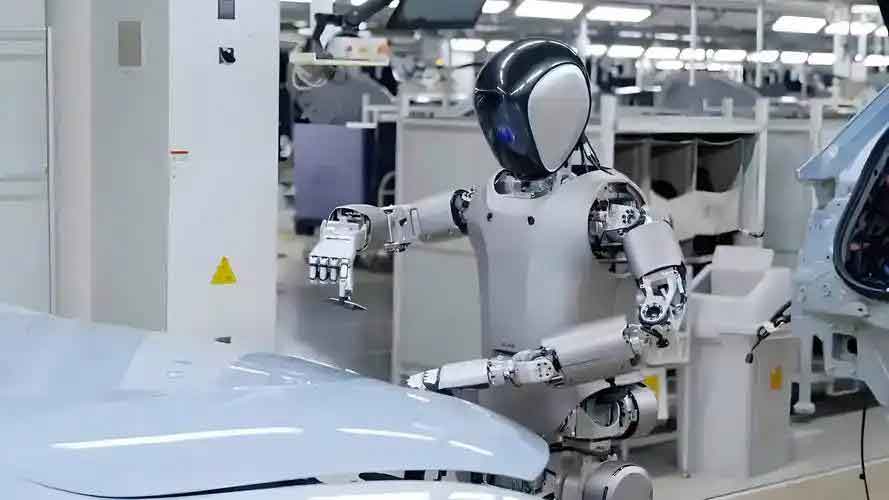
At the entrance of Shenzhen-based Zhongqing Robotics, a humanoid robot clad in a “gray hoodie” strides forward with remarkable human-like precision. Its chest display flickers through vibrant patterns as visitors capture the moment, marveling at the seamless integration of technology and biomechanics. This demonstration represents just a fraction of the breakthroughs emerging from this pioneering startup.
1. Revolutionizing Humanoid Mobility
Zhongqing Robotics has rapidly positioned itself at the forefront of humanoid robot development. In October 2024, the company unveiled the world’s first full-size humanoid robot featuring biomimetic straight-knee gait technology. Merely four months later, they stunned the global tech community by achieving another milestone: the world’s first humanoid robot capable of executing a forward somersault. These consecutive breakthroughs demonstrate unprecedented progress in dynamic motion control for humanoid robots, pushing boundaries in balance, power management, and kinematic algorithms.
2. The Decade-Long Pursuit of a Visionary
Behind these achievements stands Zhao Tongyang, founder and CEO of Zhongqing Robotics. His journey with humanoid robots began in 2016, navigating what he describes as “a path paved with challenges.” Before establishing Zhongqing, Zhao endured multiple entrepreneurial setbacks including funding shortages and company acquisitions. “This industry requires deep accumulation,” Zhao reflects. “True innovation never emerges overnight.” After his previous venture was acquired by a Guangzhou enterprise in late 2023, Zhao allocated one year’s tuition for his children and invested his remaining capital to establish Zhongqing Robotics in Shenzhen. His unwavering mission: “To bring soulful humanoid robots into every household.”
3. Assembling the Dream Team
The company’s explosive growth – from a one-person operation to a 50-member team within a year – stems from Zhao’s strategic talent acquisition. Zhongqing’s workforce spans robotics design, algorithm development, and supply chain management. Zhao likens himself to the Tang Monk from Journey to the West: “I may not be the most technically advanced, but I excel at uniting talents like Sun Wukong and Sha Seng.” This collaborative approach focuses on maximizing individual strengths to build formidable technological barriers. Every Zhongqing engineer must demonstrate exceptional passion for robotics and commitment to surpassing industry standards. “When 70% of the industry settles for 80% quality, we push beyond 95%,” states Zhao. This philosophy underpins their full-stack proprietary technology covering core components, motion control algorithms, and dynamic systems.
4. Engineering Breakthroughs: From Gait to Acrobatics
The development of biomimetic locomotion began years before Zhongqing’s founding. Dissatisfied with the bent-knee, shuffling gait of existing humanoid robots, Zhao’s earlier teams collected thousands of human walking samples across parks and streets between 2016-2018. This extensive motion capture database became the foundation for training algorithms that eventually produced SE01, their inaugural straight-knee gait humanoid robot. When critics questioned the robot’s capabilities beyond walking, the team responded with the somersault breakthrough. “Our parallel development approach and established motion control frameworks allowed us to achieve the flip in just two months,” Zhao explains. The somersault represents more than spectacle – it demonstrates the humanoid robot’s advanced spatial awareness, torque management, and impact resistance.
5. Market Response and Commercial Applications
Demand for Zhongqing’s humanoid robots has surged following their public demonstrations. The PM01 model has entered presale phase, generating hundreds of daily inquiries and over a hundred serious purchase intentions. Clients span diverse sectors including education, healthcare, and entertainment. One industrial buyer from the coal sector has expressed interest in ordering thousands of units. “I’ve followed Zhongqing’s progress closely,” commented Mr. Kang, a visiting business owner. “The potential applications in my industry are tremendous.” Educational institutions envision using these humanoid robots for STEM programs, while healthcare providers explore mobility assistance applications.
6. Shenzhen’s Ecosystem Advantage
Zhao attributes their rapid progress to Shenzhen’s unique innovation environment. The city’s manufacturing capabilities and integrated supply chains enable unprecedented efficiency in prototyping and production. “Shenzhen allows us to transform concepts into functional humanoid robots while maintaining strict cost control,” Zhao notes. The company is actively collaborating with Shenzhen-based AI leaders to enhance cognitive capabilities. “The convergence of hardware expertise and AI innovation here creates the perfect conditions for advanced humanoid robot development,” Zhao emphasizes. This ecosystem synergy reduces component sourcing time from weeks to days and provides access to specialized engineering talent.
7. The Road Ahead: Humanoid Robots in Daily Life
Looking toward 2025, Zhongqing plans to “push humanoid robots’ physical capabilities to their limits.” The company’s roadmap includes enhanced dexterity for object manipulation, improved energy efficiency for extended operation, and more sophisticated human-robot interaction systems. Zhao envisions humanoid robots transitioning from industrial settings to domestic environments within 3-5 years. “The somersault opened people’s imagination about what humanoid robots can achieve,” he observes. “Soon we’ll demonstrate practical applications that redefine human productivity and quality of life.” As Zhongqing continues refining their humanoid robot platform, the once-distant dream of intelligent mechanical companions in every home appears increasingly tangible.
| Humanoid Robot Model | Key Innovation | Development Timeline |
|---|---|---|
| SE01 | World’s first biomimetic straight-knee gait system | Launched October 2024 |
| Experimental Prototype | Forward somersault capability | Achieved February 2025 |
| PM01 | Multi-scenario application platform | Presale launched March 2025 |
The accelerating progress in humanoid robot technology signals a paradigm shift in human-machine collaboration. With companies like Zhongqing Robotics overcoming fundamental mobility challenges and demonstrating real-world applications, the era of accessible humanoid robots appears imminent. As these machines evolve from laboratory curiosities to functional assistants, they promise to transform industries and households alike – a testament to persistent innovation in Shenzhen’s vibrant tech ecosystem.